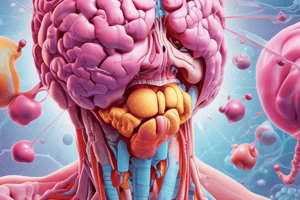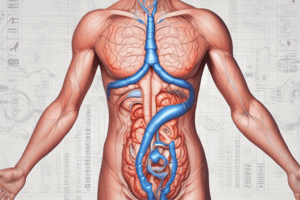Podcast
Questions and Answers
Which function is primarily associated with the endocrine system's role in development?
Which function is primarily associated with the endocrine system's role in development?
- Stimulating growth and development throughout childhood and adolescence. (correct)
- Initiating immediate pain responses to physical injuries.
- Facilitating communication between the digestive and nervous systems.
- Regulating blood pressure during periods of high stress.
How does the endocrine system contribute to maintaining an optimal internal environment?
How does the endocrine system contribute to maintaining an optimal internal environment?
- Facilitating rapid responses to external stimuli through electrical signals.
- Regulating temperature through sweat glands and shivering reflexes.
- Secreting hormones that regulate various physiological processes. (correct)
- Neutralizing external pathogens through the release of antibodies.
What is the primary mechanism by which the endocrine system achieves its regulatory functions?
What is the primary mechanism by which the endocrine system achieves its regulatory functions?
- Releasing enzymes directly at target sites.
- Transmission of electrical impulses through neurons.
- Secretion of hormones into the bloodstream. (correct)
- Physical connections between organs.
In emergency situations, the endocrine system is responsible for which critical function?
In emergency situations, the endocrine system is responsible for which critical function?
What role does the endocrine system play in the early stages of human development?
What role does the endocrine system play in the early stages of human development?
Which factor primarily contributes to the increased risk of thrombus formation in individuals with diabetes?
Which factor primarily contributes to the increased risk of thrombus formation in individuals with diabetes?
What is the primary underlying cause of cardiovascular complications, such as coronary artery disease and stroke, in individuals with diabetes?
What is the primary underlying cause of cardiovascular complications, such as coronary artery disease and stroke, in individuals with diabetes?
How does the survival rate typically differ for individuals with diabetes who experience a severe stroke compared to those without diabetes?
How does the survival rate typically differ for individuals with diabetes who experience a severe stroke compared to those without diabetes?
What is the combined effect of atherosclerosis and peripheral neuropathy in individuals with diabetes regarding lower extremity health?
What is the combined effect of atherosclerosis and peripheral neuropathy in individuals with diabetes regarding lower extremity health?
What is the potential impact of specialist referrals on amputation rates for individuals with diabetes-related foot lesions?
What is the potential impact of specialist referrals on amputation rates for individuals with diabetes-related foot lesions?
How do incretins contribute to the regulation of blood glucose levels?
How do incretins contribute to the regulation of blood glucose levels?
What is the primary function of somatostatin produced by the delta cells of the pancreas?
What is the primary function of somatostatin produced by the delta cells of the pancreas?
How does ghrelin influence appetite and growth hormone secretion?
How does ghrelin influence appetite and growth hormone secretion?
What triggers the release of pancreatic polypeptide, and what is its effect?
What triggers the release of pancreatic polypeptide, and what is its effect?
In type 1A diabetes, which process leads to a deficiency in insulin production?
In type 1A diabetes, which process leads to a deficiency in insulin production?
A patient presents with gynecomastia, testicular atrophy, and decreased libido. Which hormonal imbalance is the MOST likely cause?
A patient presents with gynecomastia, testicular atrophy, and decreased libido. Which hormonal imbalance is the MOST likely cause?
A female patient is diagnosed with hirsutism, clitoral enlargement, and a deepening of her voice. Which condition should be suspected?
A female patient is diagnosed with hirsutism, clitoral enlargement, and a deepening of her voice. Which condition should be suspected?
What is the PRIMARY mechanism behind secondary hyperaldosteronism?
What is the PRIMARY mechanism behind secondary hyperaldosteronism?
Which of the following conditions is characterized by hypocortisolism and hypoaldosteronism due to autoimmune mechanisms?
Which of the following conditions is characterized by hypocortisolism and hypoaldosteronism due to autoimmune mechanisms?
A patient presents with symptoms similar to Addison disease, but hyperpigmentation is absent. What is the MOST likely cause?
A patient presents with symptoms similar to Addison disease, but hyperpigmentation is absent. What is the MOST likely cause?
A child is exhibiting precocious sexual development and advanced bone aging. Which hormonal condition is MOST likely responsible?
A child is exhibiting precocious sexual development and advanced bone aging. Which hormonal condition is MOST likely responsible?
What is the underlying cause of a pheochromocytoma?
What is the underlying cause of a pheochromocytoma?
A patient is diagnosed with Conn disease. What is the MOST likely underlying pathology?
A patient is diagnosed with Conn disease. What is the MOST likely underlying pathology?
Which characteristic distinguishes tropic hormones from non-tropic hormones?
Which characteristic distinguishes tropic hormones from non-tropic hormones?
How do water-soluble hormones differ from lipid-soluble hormones in their transport within the circulatory system?
How do water-soluble hormones differ from lipid-soluble hormones in their transport within the circulatory system?
What determines a target cell's sensitivity to a specific hormone?
What determines a target cell's sensitivity to a specific hormone?
What is the primary difference between the mechanism of action of water-soluble and lipid-soluble hormones at their target cells?
What is the primary difference between the mechanism of action of water-soluble and lipid-soluble hormones at their target cells?
How does negative feedback regulate hormone release, and why is it the most common feedback mechanism?
How does negative feedback regulate hormone release, and why is it the most common feedback mechanism?
What is the function of signal transduction in hormone action?
What is the function of signal transduction in hormone action?
Which of the following hormones is a peptide?
Which of the following hormones is a peptide?
What is the difference between hormone up-regulation and down-regulation?
What is the difference between hormone up-regulation and down-regulation?
Which of the following is a characteristic of hormone secretion rhythms?
Which of the following is a characteristic of hormone secretion rhythms?
How does the half-life of a hormone affect its duration of action, and what type of hormone generally has a longer half-life?
How does the half-life of a hormone affect its duration of action, and what type of hormone generally has a longer half-life?
Syndrome of Inappropriate Antidiuretic Hormone (SIADH) is often characterized by which of the following?
Syndrome of Inappropriate Antidiuretic Hormone (SIADH) is often characterized by which of the following?
What is the primary difference between neurogenic and nephrogenic diabetes insipidus?
What is the primary difference between neurogenic and nephrogenic diabetes insipidus?
A patient presents with increased bone density, hyperglycemia, and proliferation of connective tissue. Which condition is most likely responsible for these manifestations?
A patient presents with increased bone density, hyperglycemia, and proliferation of connective tissue. Which condition is most likely responsible for these manifestations?
Which of the following hormonal deficiencies would NOT be a direct consequence of hypopituitarism?
Which of the following hormonal deficiencies would NOT be a direct consequence of hypopituitarism?
A patient is diagnosed with a prolactinoma. Which of the following could potentially cause hypersecretion of prolactin, besides the tumor itself?
A patient is diagnosed with a prolactinoma. Which of the following could potentially cause hypersecretion of prolactin, besides the tumor itself?
What is the most common cause of hyperpituitarism?
What is the most common cause of hyperpituitarism?
Which condition associated with the posterior pituitary can be triggered by ectopic secretion of ADH, common after surgery or in some cancers?
Which condition associated with the posterior pituitary can be triggered by ectopic secretion of ADH, common after surgery or in some cancers?
What is the primary function of calcitonin, which is secreted by the parafollicular cells (C cells) of the thyroid gland?
What is the primary function of calcitonin, which is secreted by the parafollicular cells (C cells) of the thyroid gland?
A child is diagnosed with gigantism. Which of the following hormonal imbalances is the most likely cause?
A child is diagnosed with gigantism. Which of the following hormonal imbalances is the most likely cause?
Damage to the pituitary stalk can lead to hypopituitarism. What is the primary mechanism by which this damage impairs pituitary function?
Damage to the pituitary stalk can lead to hypopituitarism. What is the primary mechanism by which this damage impairs pituitary function?
Melatonin secretion by the pineal gland is primarily regulated by:
Melatonin secretion by the pineal gland is primarily regulated by:
Which deficiency leads to a lack of secondary sex characteristics?
Which deficiency leads to a lack of secondary sex characteristics?
What is a key characteristic that distinguishes dipsogenic diabetes insipidus from neurogenic and nephrogenic forms?
What is a key characteristic that distinguishes dipsogenic diabetes insipidus from neurogenic and nephrogenic forms?
Which gland(s) are located lateral to the trachea and connected by the isthmus?
Which gland(s) are located lateral to the trachea and connected by the isthmus?
Why is the pituitary gland particularly vulnerable to ischemia and infarction?
Why is the pituitary gland particularly vulnerable to ischemia and infarction?
Flashcards
Endocrine System: Fetal Development
Endocrine System: Fetal Development
Directs reproductive and CNS differentiation in the fetus.
Endocrine System: Growth Stages
Endocrine System: Growth Stages
It guides growth and development throughout childhood and adolescence.
Endocrine System: Reproduction
Endocrine System: Reproduction
Coordinates both the male and female reproductive functions.
Endocrine System: Homeostasis
Endocrine System: Homeostasis
Signup and view all the flashcards
Endocrine System: Emergency Response
Endocrine System: Emergency Response
Signup and view all the flashcards
Incretins
Incretins
Signup and view all the flashcards
Amylin
Amylin
Signup and view all the flashcards
Somatostatin
Somatostatin
Signup and view all the flashcards
Ghrelin
Ghrelin
Signup and view all the flashcards
Diabetes Mellitus
Diabetes Mellitus
Signup and view all the flashcards
Hormones
Hormones
Signup and view all the flashcards
Tropic Hormones
Tropic Hormones
Signup and view all the flashcards
Non-Tropic Hormones
Non-Tropic Hormones
Signup and view all the flashcards
Regulation of Hormone Release
Regulation of Hormone Release
Signup and view all the flashcards
Negative Feedback
Negative Feedback
Signup and view all the flashcards
Hormone Transport
Hormone Transport
Signup and view all the flashcards
Hormone Receptors
Hormone Receptors
Signup and view all the flashcards
Up-Regulation
Up-Regulation
Signup and view all the flashcards
Down-Regulation
Down-Regulation
Signup and view all the flashcards
Signal Transduction
Signal Transduction
Signup and view all the flashcards
Diabetes-related Microvascular Disease
Diabetes-related Microvascular Disease
Signup and view all the flashcards
Diabetes-related Cardiomyopathy
Diabetes-related Cardiomyopathy
Signup and view all the flashcards
Diabetes-related Stroke
Diabetes-related Stroke
Signup and view all the flashcards
Diabetes-related Peripheral Arterial Disease (PAD)
Diabetes-related Peripheral Arterial Disease (PAD)
Signup and view all the flashcards
Diabetes & Infections
Diabetes & Infections
Signup and view all the flashcards
SIADH
SIADH
Signup and view all the flashcards
Diabetes Insipidus
Diabetes Insipidus
Signup and view all the flashcards
Neurogenic Diabetes Insipidus
Neurogenic Diabetes Insipidus
Signup and view all the flashcards
Nephrogenic Diabetes Insipidus
Nephrogenic Diabetes Insipidus
Signup and view all the flashcards
Dipsogenic Diabetes Insipidus
Dipsogenic Diabetes Insipidus
Signup and view all the flashcards
Hyperpituitarism
Hyperpituitarism
Signup and view all the flashcards
Hypopituitarism
Hypopituitarism
Signup and view all the flashcards
Hyperaldosteronism
Hyperaldosteronism
Signup and view all the flashcards
Panhypopituitarism
Panhypopituitarism
Signup and view all the flashcards
Gigantism
Gigantism
Signup and view all the flashcards
Secondary Hyperaldosteronism
Secondary Hyperaldosteronism
Signup and view all the flashcards
Acromegaly
Acromegaly
Signup and view all the flashcards
Hypersecretion of Estrogens
Hypersecretion of Estrogens
Signup and view all the flashcards
Prolactinomas
Prolactinomas
Signup and view all the flashcards
Hypersecretion of Androgens
Hypersecretion of Androgens
Signup and view all the flashcards
Prolactinoma
Prolactinoma
Signup and view all the flashcards
Hirsutism
Hirsutism
Signup and view all the flashcards
Melatonin
Melatonin
Signup and view all the flashcards
Addison Disease
Addison Disease
Signup and view all the flashcards
Pineal Gland
Pineal Gland
Signup and view all the flashcards
Secondary Hypocortisolism
Secondary Hypocortisolism
Signup and view all the flashcards
Pheochromocytomas
Pheochromocytomas
Signup and view all the flashcards
Parafollicular cells (C cells)
Parafollicular cells (C cells)
Signup and view all the flashcards




